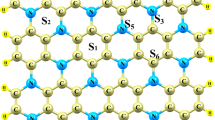Abstract
Na–C intercalation is one of the major causes for cathode deterioration in reduction cells, in which the initial stage is important for understanding the microstructure evolution and developing strategy for cathode improvement. In this paper, a single sodium atom adsorbed on a single carbon layer for assembling one of multiple layers of graphite, has been investigated using first principles density functional theory (DFT). Results show that the center of a carbon ring is the preferred site for sodium adsorption at the initial stage of Na–C contact. When the single layer structure vary from (\( \sqrt 7 \) × \( \sqrt 7 \)) to (5 × 5) in pattern, adsorption energy of sodium–carbon system has a parabolic trend and the supercell of Na/C = 1/14 has the lowest absolute value of adsorption energy in this paper due to the influences of both charge transfer and Coulomb interaction, while other geometry properties change monotonically as sodium coverage increasing. Carbon p and sodium s and p states can all contribute to the density of states at Fermi level. The Fermi energy of graphene increases due to charge transfer form sodium to graphene.
Access this chapter
Tax calculation will be finalised at checkout
Purchases are for personal use only
Similar content being viewed by others
References
Sorlie M, Oye AH (2010) Cathodes in Aluminum Electrolysis. Aluminium-Verlag Marketing & Kommunikation GmbH, Dusseldorf.
Li X, Xue J, Chen T (2013) Characterization of Porous Structure and Its Correlation to Sodium Expansion of Graphite Cathode Materials Using Image Analysis. TMS Light Metals 12:1263–1267.
Xue J, Wu L, Wang W, et al. (2010) CHARACTERIZATION OF SODIUM EXPANSION IN INDUSTRIAL GRAPHITIC AND GRAPHITIZED CATHODES[J]. TMS Light Metals 2010.
Rytkönen K, Akola J, Manninen M (2004) Sodium atoms and clusters on graphite by density functional theory. Physical Review B 69(20):1324–1332.
Wang Z, Selbach S M, Grande T (2014) Van der Waals density functional study of the energetics of alkali metal intercalation in graphite. Rsc Advances 4(8):4069–4079.
Neto AHC, Guinea F, Peres NMR, et al. (2009) The electronic properties of graphene. REVIEWS OF MODERN PHYSICS 81:109–162.
Kaur G, Gupta S, Rani P, et al. (2015) Theoretical investigation of structures and energetics of sodium adatom and its dimer on graphene: DFT study. Physica E: Low-dimensional Systems and Nanostructures 74:87–92.
Okamoto Y (2014) Density Functional Theory Calculations of Alkali Metal (Li, Na, and K) Graphite Intercalation Compounds. Journal of Physical Chemistry C118(1):16–19.
Jin KH, Choi SM, Jhi SH (2010) Crossover in the adsorption properties of alkali metals on graphene. Physical Review B Condensed Matter 82(82):033414.
Stevens, DA (2000) Mechanisms for Sodium Insertion in Carbon Materials. National Library of Canada, Halifax.
Qiao L, Qu CQ, Zhang HZ, et al. (2010) Effects of alkali metal adsorption on the structural and field emission properties of graphene. Diamond & Related Materials 19(11):1377–1381.
Zhu ZH, Lu GQ (2004) Comparative study of Li, Na, and K adsorptions on graphite by using ab initio method. Langmuir the Acs Journal of Surfaces & Colloids 20(24):10751.
RytkÖ K, nen, Akola J, et al. (2007) Density functional study of alkali metal atoms and monolayers on graphite (0001). Physical Review B 75(7):794–802.
Malyi OI, Sopiha K, Kulish VV, et al. (2015) A computational study of Na behavior on graphene. Applied Surface Science 333:235–243.
Nakada K, Ishii A (2011) Migration of adatom adsorption on graphene using DFT calculation. Solid State Communications 151(1):13–16.
Chan KT, Neaton JB, Cohen ML (2008) First-principles study of metal adatom adsorption on graphene. Physical Review B Condensed Matter 77:235430.
Guo X, Zhou YG (2013) Band gaps of graphene on layered ZnO substrate: A first principles study. Journal of Applied Physics 113(5):054307–054304.
Zhou W, Zhou J, Shen J, et al (2012) First-principles study of high-capacity hydrogen storage on graphene with Li atoms. Journal of Physics & Chemistry of Solids 73(2):245–251.
Nobuhara K, Nakayama H, Nose M, et al (2013) First-principles study of alkali metal-graphite intercalation compounds. Journal of Power Sources 243(6):585–587.
Csányi G, Littlewood PB, Nevidomskyy AH, et al. (2005) The role of the interlayer state in the electronic structure of superconducting graphite intercalated compounds. Nature Physics 1:42–45.
Kamakura N, Kubota M, Ono K (2008) Band dispersion and bonding character of potassium on graphite. Surface Science 602(602):95–101.
Ri GC, Yu CJ, Kim JS, et al. (2016) First-principles study of ternary graphite compounds cointercalated with alkali atoms (Li, Na, and K) and alkylamines towards alkali ion battery applications. Journal of Power Sources 324:758–765.
Nazrul Rosli A, Fatimah Wahab I, Zabidi N A, et al. (2015) The Study of Band Structure of Graphite Intercalation Compound Containing Sodium Calculated Using Density Functional Theory. Journal of Physics: Conference Series 012049.
Dresselhaus MS, Dresselhaus G (2002) Intercalation compounds of graphite. Advances in Physics 51(1):1–186.
Acknowledgements
Supports from National Natural Science Foundation of China (Nos. 51434005 and 51674025) are gratefully acknowledged.
Author information
Authors and Affiliations
Corresponding author
Editor information
Editors and Affiliations
Rights and permissions
Copyright information
© 2018 The Minerals, Metals & Materials Society
About this paper
Cite this paper
Sun, J., Xue, J., Liu, X., Wang, Z., Li, L. (2018). Simulation on the Initial Stage of Sodium–Graphite Intercalation Using First-Principles Calculation. In: Martin, O. (eds) Light Metals 2018. TMS 2018. The Minerals, Metals & Materials Series. Springer, Cham. https://doi.org/10.1007/978-3-319-72284-9_175
Download citation
DOI: https://doi.org/10.1007/978-3-319-72284-9_175
Published:
Publisher Name: Springer, Cham
Print ISBN: 978-3-319-72283-2
Online ISBN: 978-3-319-72284-9
eBook Packages: Chemistry and Materials ScienceChemistry and Material Science (R0)




